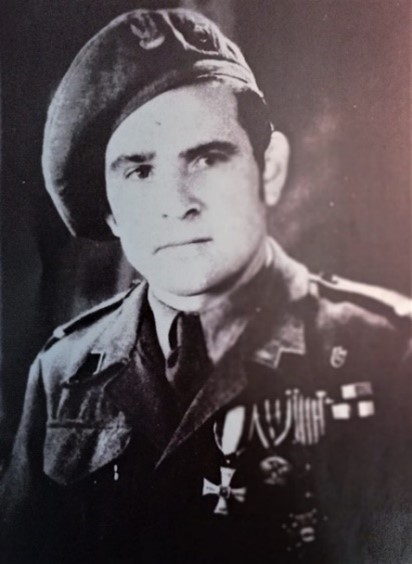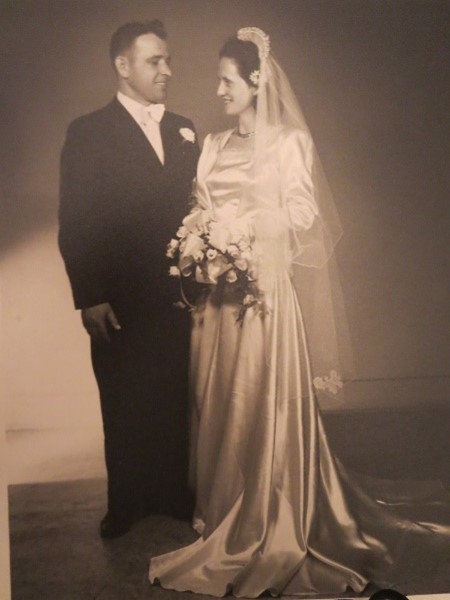

Born: February 8, 1917, Kamionka Wołoska (Lipnik) (pow. Rawa Ruska, woj. lwowskie, Poland)
Died: September 16, 1995 in London, Ontario, Canada
Buried : St. Peter’s Cemetery, London, Ontario, Canada
Family: father Piotr (1888-1971); mother Anna (maiden name : Zyhailo) (1890-1965)
Military Medals: Polish Medals: Medal Wojska; Krzyż Pamiątkowy Monte Cassino; British Medals: 1939-1945 Star; Italy Star
Fates before joining Anders Army : On a December Sunday in 1939, Gnidec and some others were arrested by eight men in a Soviet truck. He was detained in a prison in Rawa Ruska for two weeks. Later he was transported to a hard penitentiary in Brygidki Jail (Lviv). They slept on 4’8’ slabs of wood and were not permitted to step outside. He stayed there until mid-April 1940, when he was transported to Kiev by train. He was held at a railway station in an open field for two weeks before being taken to Kharkov, where he stayed in a jail located in a former monastery, where he was “tried” and interrogated from midnight to 2:00 a.m. He was continuously asked “why were you spying” and consistently maintained that he had only gone to see the girls in the neighbouring village. The food rations in the Kharkov jail included 20 g of sugar daily.
On September 1, 1940, Gnidec and other prisoners were transported by train to Arkhangelsk and then by coal boat to St. Maran. There were about 450 men, of which about 250 were Polish. The others were Russians, Germans, Hungarians and Romanians. They took an open barge out of St. Maran and sailed along the Peczora River.
On October 28, 1940, they were forced to stop their journey due to the fact that the river had frozen over. Two weeks later, once they were certain that the water was frozen over, the men were forced to walk across the ice for four days and three nights. In the middle of December 1940, they arrived in a work camp 40 km from Vorkuta. They were forced to build a railroad from Kotlas to Vorkuta. They received 60 g of sugar per month as part of their food rations, which was not nearly enough, since Gnidec was hospitalized for malnutrition for four to five weeks in the summer of 1941. He also traded his new boots for some fish at the food reserve.
This cost him dearly because two guards caught him cooking the fish and accused him of stealing them. He refused to get dressed when they ordered him to do so, and they then ordered him to run barefoot in minus 40 C weather to the guard post, where he was locked up in an unheated room. The room that Gnidec was kept in may have been unheated, but it was next to the guard’s room, and, luckily, the stove stood against the shared wall of the two rooms. Gnidec sat beside the wall which had the stove on the other side of wall in the guard’s room to keep warm.
Military history: In 1941 the Polish government-in-exile in England signed an agreement freeing the prisoners and allowing the creation of a Polish Army on Soviet territory. On September 1, 1941, they released Teodor and 29 others from the Vorkuta camp. Gnidec received 300 rubles and enough food rations to last three days. He walked for six to eight hours to the train station, picking and eating blueberries along the way. Two weeks later he was allowed to report at any of the main train stations.
He took the train to Buzuluk, where he stayed for two weeks before taking another train to Tatishchevo, where he arrived during the first week of October 1941. Polish General Anders organized a training camp in Tatishchevo. In March/April 1942, Gnidec left Tatishchevo for Blagowieszczenka, Uzbekistan, a village known for its cotton plantations. Because of the harsh conditions in Uzbekistan, the Polish Commanders requested that their Army be transferred to the Middle East. In the spring and summer of 1942, some 100,000 Poles in total left the Soviet Union. They travelled through Persia to Middle East where the British 8th Army was located and where the 2nd Corps was formed. The troops took a boat from the Krasnovodsk port across the Caspian Sea to the port of Pahlevi and then Tehran. From Iran, they took trucks driven by experienced drivers from Tehran through the mountains to Khanaqin, Iraq, outside of Kirkuk, where they stayed from January to August 1943. There, they trained in temperatures ranging from 16 F by day to below freezing by night. They continued their training from September to mid October 1943 in the mountainous region of Lebanon.
They took a truck out of Lebanon to Palestine, where they could tour Bethlehem and Jerusalem and to relax before the upcoming hardships.
In December of 1943, they moved to Egypt, where Gnidec took the opportunity to tour Cairo and see the pyramids and other sites. They took boats to the port in Taranto, Italy, at the beginning of February 1944. At the end of the month, they were stationed at Campobasso.
They took over the French Army’s position at San Giovanni a few days before Easter of 1944.
Their next stop was Castrocaro near Cassino, where they trained in mountain and bush terrain (5th Kresowa Infantry Division, 13th Wilno Rifle Battalion). They arrived in Monte Cassino on May 5/6, 1944, and stayed in the trenches until May 11. On that day, some 16,000 artillery pieces began bombarding the Germans at 11:00 PM; the battle began. Gnidec lost consciousness when a grenade exploded near him. During this battle, he was wounded in his left arm, left thigh and the back of his head. He was transported to the hospital, where he stayed for six weeks. During the battle, forty-six members of Gnidec’s company died and forty-eight were wounded. They attacked Monte Cassino again on May 18th. This time, they were successful: they captured Monte Cassino and opened the gateway to Rome. Three days after Gnidec returned from the hospital, the Corps captured Ancona.
On August 1 or 2, 1944, the Polish soldiers participated in the King George VI parade in Ostra.
At 3:30 PM, on August 31, 1944, Gnidec was once again wounded, this time severely, in the right arm, while carrying a dead fellow soldier. He was hospitalized and received skin grafts.
Gnidec rejoined the Corps in Galeata in the middle of November 1944. They spent Christmas and New Year’s near Bologna, a city they captured in April of 1945. In the middle of April 1945, Gnidec achieved the status of Lance Corporal after officer training at the army school.
Post-War: At the end of the war, Gnidec stayed in Italy. He studied for six weeks in Modena. Next, the Corps relocated to Naples. In August of 1946, Canadian diplomats came to Italy looking for 6,000 healthy, unmarried men to work on farms. Many of the Polish soldiers chose this option over returning to the now Communist Poland. In November of 1946, Gnidec left Italy for Canada with the first group of Polish soldier immigrants. He sailed on the second boat from Naples to Halifax. Each immigrant had to sign a two-year contract to work as a farm labourer. Many filled farm labourer positions previously held by German prisoners of war ,who had returned to Germany when the war was over. In Halifax, the immigrants were distributed to the farms. Gnidec was sent to St. Thomas, Ontario, and worked on tobacco farms in Mount Brydges, from 1947 to 1949.
He moved to London in June 1949. He lived on the third floor and paid 5 cents a week to his landlords, the Atkinsons. This floor had four bedrooms, a common bathroom and a cooking area. He shared the floor with a fellow Pole, a pharmacist and a worker for Dion Movers. Gnidec received his Canadian citizenship in 1951/early 1952. The Atkinsons were his witnesses. His first job in London was rebuilding the roof of Bishop Cronyn Anglican Church for an hourly wage of eighty-five cents. Later he worked as an orderly at Westminster Veteran’s Hospital until he injured his back. After that he worked as a carpenter. In 1978, he and his sons established the E&A Gnidec Bros. General Construction Company.
In London, Teodor joined SPK, Branch No. 2, where he was a founding member. He was a proud and active member and felt strongly affiliated with the organization. He was involved with building both Our Lady of Częstochowa Church and the SPK Hall.
author : Stan Skrzeszewski
source : “Book of Remembrance / Książka Pamięci”, Polish Combatant’s Association, Branch 2. London, Ontario, Canada, 2018.







